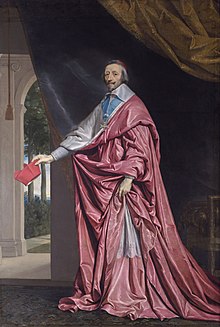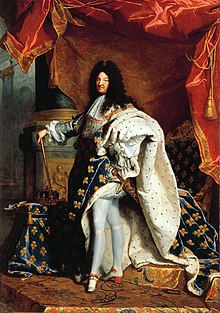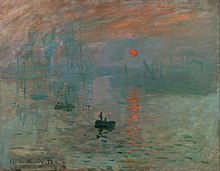France painting
The name French painting can refer to all the painting done in what is now France.
Prehistory
Its first manifestations occurred in prehistoric art, within rock art. It does not occur throughout the French territory, but is concentrated in certain areas, but where limestone and sandstone offer suitable tables. In the richest area, located in the Périgord, you can find the most famous caves: Lascaux, Combarelles, Font-de-Gaume, Gabillou or Rouffignac. The prehistoric sites and decorated caves of the Vézère valley are declared a World Heritage Site in Europe by Unesco.
There is another area in the French Pyrenees, such as Massar (Ariège), Gourdan (Haut-Garonne), Bruniquel (Tarn-et-Garonne), and others in the Bajos-Pyrénées and Hautes-Pyrénées departments.
They are paintings made in the caves, representing animals (the horse and the bison, mainly), as well as human figures and signs. Its purpose has not yet been fully determined, having been interpreted as a religious art.
Baroque
17th century
At the beginning of the XVII century, the tendencies of the second Fontainebleau school persisted. The return of Simon Vouet, prince of the Academy of Saint Luke from 1624 to 1627, in 1627 marks the beginning of the recovery of French painting. This painter is considered the most properly Baroque.
The naturalism of Caravaggesque origin is represented in the work of Valentin de Boulogne († 1634), the famous tenebrist Georges de La Tour († 1652) who develops his work in the court of Lorraine and in peasant scenes painted in hand manner of a genre scene by the Le Nain brothers: Antoine, Louis and Matheo.
The great masters of classicism are Nicolas Poussin (1594-1665), a painter of mythological and historical subjects, and Claude Lorrain (1600-1682), a prominent landscape painter who influenced Romanticism and even the origins of Impressionism. Both reside in Rome, but receive continuous commissions for their country. They work on the dominant problem of the expression of atmospheric perspective. Poussin plays a decisive role in the rapid perfection of the French school on his brief return to Paris (1640-1642).
In the French court of Louis XIII and Louis XIV, portraiture was cultivated profusely. The Flemish Philippe de Champaigne (1602-74) initiated the genre, with representations of courtly characters in all their splendor and who in his secular portraits reached a more mundane expression; It was continued by portrait painters dating back to the 18th century: Hyacinthe Rigaud (1659-1747) and Nicolas de Largillière (1656-1746), who restored to the portrait its plastic quality, but with a search for sumptuousness and eloquence that excluded depth of analysis..
In the pictorial life of this century, the creation of the Royal Academy of Fine Arts (1648) stands out, to overcome the old corporation of painters, as a guild or trade, advocating instead that it be seen as a " liberal art". Charles Le Brun was the academic painter par excellence, the king's painter since 1664, who exercises authentic artistic tyranny. Le Brun achieves the ideal of the great lord painter and friend of the sovereign. Along with him, it is worth mentioning the courtly portrait painter Pierre Mignard, who tends the portrait towards a graceful and empty formula.
Antoine Coypel and Charles de la Fosse († 1716) are the last exponents of Italian-inspired Baroque trends.
18th century
In this century, Rococo predominates, paintings full of liveliness and typically French charm, with names like Watteau, Boucher or Fragonard.
At the beginning of the century, Hyacinthe Rigaud continued to work, whose Portrait of Louis XIV, kept in the Louvre Museum, is generally considered the most representative image of the Great Century. Le Brun continues to set trends from the Academy, an institution that enjoys great stability. Although young artists continue to go to Rome to train, there is a certain displacement, paying more attention to the works that are carried out in Venice.
The forms of the classical style give way, in the reign of Louis XV, to the Rococo style. Its oldest representative is Antoine Watteau (1684-1721), creator of the genre of fêtes galantes ("gallant parties"). François Boucher (1703-70) is the painter of sensuality, of female nudes. Finally, Jean-Honoré Fragonard (1732-1806) combines the making of gallant scenes and other more sentimental ones that prelude romanticism.
This sentimental and somewhat tearful tone is evident in the work of Jean-Baptiste Greuze (1725-1815).
The palace portrait continues to be cultivated, the pastel technique becoming fashionable. Nattier († 1766) is the painter of the ladies of the nobility, with light colors and allegorical representations. Maurice Quentin de La Tour († 1788), is the greatest pastellist of the century, with great psychological insight. Finally, Jean Siméon Chardin (1699-1779) cultivates the still life, and Dutch-inspired scenes.
19th century
It is the century of great French painting. Paris becomes a first-rate artistic reference. It is the city to which painters from all over Europe travel to train, thus succeeding Rome. The great artistic movements arose in the French capital: romanticism, realism, impressionism, post-impressionism.
Neoclassicism
Between the 18th and 19th centuries, neoclassicism developed as a reaction to Rococo excesses. It embodies the ideals of the Enlightenment and became the art of the French Revolution first and of the Napoleonic Empire later.
The most outstanding artist is Jacques-Louis David (1748-1825), who in 1784 had presented Oath of the Horatii. As a Napoleonic painter he stands out in The coronation of Napoleon I in Notre Give me (1805-7).
Antoine-Jean Gros (1771-1835) follows Napoleon on his campaigns, his best-known work being Napoleon Visiting the Plagued in Jaffa (1804).
Jean Auguste Dominique Ingres (1780-1867) is neoclassical, although the influence of romanticism is noticeable in a certain orientalizing tendency (The Odalisque).
Romanticism
Romanticism is already noticeable in a disciple of David, François Gérard (1770-1837), who paints portraits in the sentimental style of the new era.
The most prominent French Romantic painters were Pierre Proudhon (1758-1823); Théodore Géricault (1791-1824), whose best-known work is The Raft of the Medusa; and Eugène Delacroix (1798-1863), with works such as The Chios Massacres and The Death of Sardanapalus.
Realism
As early as 1831, an evolution towards realism can be seen, with works that reflect a realistic landscape: Camille Corot (1796-1875), painter of the transition between classical and realistic landscapes. The landscape painters of the Barbizon School are also realistic.
Testimonial realism, which reflects the daily life of the people, is represented by authors such as:
- Jean-François Millet (1814-75), whose best known work is The Angelus (1857-59)
- Gustave Courbet (1819-77), whose most famous work is The burial in Ornans.
- Honoré Daumier (1808-79).
Impressionism
In 1874, the first collective exhibition of the Impressionists was held in France. It is considered the most important movement in painting of the last decades of the 19th century.
Édouard Manet (1822-83) is considered a forerunner of the movement; his best-known work is Le Dejeuner sur l’herbe (Lunch on the Grass).
The painting that gave its name to this movement was Impression: Rising Sun, by Claude Monet (1840-1936), presented in the first collective exhibition (1874). Within the impressionist movement, they also painted Renoir (1841-1919), Camille Pissarro; Alfred Sisley (1839-99), more of a landscape painter; Edgar Degas, who paints urban scenes with artificial light; Berthe Morisot and Paul Cezanne (1839-1906).
Post-Impressionism
This name refers to a heterogeneous group of artists who painted between 1886 and 1907, between the last Impressionist exhibition and the rise of Cubism.
The main Post-Impressionist artists were:
- Paul Gauguin (1848-1903): Yellow Christ, Tahiti Girls.
- Henri Rousseau
- Henri de Toulouse-Lautrec (1864-1901), which shows no interest in painting outdoors, but rather follows the Degas line.
A particular current within post-impressionism is pointillism or “divisionism”, which first appeared at the Salon des Indépendants in 1884, headed by the neo-impressionist painters Georges Seurat (1859-1891) and Paul Signac (1863-1935).
For its part, symbolism began in the last two decades of the century, with painters such as Gustave Moreau (1826-1898) and Pierre Puvis de Chavannes (1824-1898).
At this same period, a series of painters were grouped together under the name "Pont-Aven School", which takes its name from the town frequented by students of the School of Fine Arts in Paris. They come to be a synthesis of impressionism and symbolism. Other painters of this school include Emile Bernard and Charles Laval.
The second symbolist generation is known as the nabi, with a fundamentally decorative aesthetic conception. Within this current, Pierre Bonnard and Edouard Vuillard can be cited.
20th century
In the first decade of the century, fauvism and cubism were born in Paris.
Fauvism
Although there were examples as far back as 1903, Faovism is a movement that developed around 1905, when a series of artists, grouped around Matisse, presented themselves at the "Salon d'autumn de 1905&# 3. 4;. Despite the scandal, they met again in the "Salón de los independientes" in 1906. Around 1908 the group dissolved, each artist following his own path.
Its most important figure is Matisse (1869-1954), whose work Interior in Red can be cited. Other notable authors are Albert Marquet (1875-1947), Manguin and Comoin. Derain (1880-1954, Port in Collioure), Maurice Vlaminck (1876-1958) and a series of painters from Le Havre were added to this group: Othon Friesz, Raoul Dufy and Georges Braque..
Cubism
Between 1907 and 1914, Cubism developed, an artistic movement whose main founders were the Spanish Pablo Picasso and the French Georges Braque. Cubism deals with the forms of nature through geometric figures, representing all the parts of an object on the same plane. It is considered the first avant-garde since it breaks with the last Renaissance statute in force at the beginning of the XX century, perspective. It makes its first collective appearance at the Salón de Independientes in 1911.
Braque departs from his initial affection for fauvism to launch himself, after learning about Picasso's work, into cubism. Other painters who spread cubism were: Albert Gleizes (1891-1953), Jean Metzinger (1883-1956), Roger de la Fresnaye (1885-1925) and Fernand Léger (1881-1955).
Deriving from Cubism are other minor art movements, such as "purism" of Charles Edouard Jeanneret (1887-1966) and Amédée Ozenfant (1886-1966) and the "orphism" launched since 1912 by the work of Robert Delaunay and František Kupka, already pre-abstract.
Abstraction
Within abstract art Robert Delaunay elaborated, from 1912, based on Chevreul's theories on the simultaneous contrast of colors, his windows and his first abstract cosmic circular forms, while František Kupka exhibited at the Salon d'Automne de 1912 Amorphous, fugue of two colors and in 1913 Blue and red vertical planes.
The abstraction of Fernand Léger (Contrastes de forme, 1913-1914) and that of Picabia (Udnie, 1913) used cubist forms without renouncing chromatic intensity.
In parallel to the constructivist abstraction, an abstraction called biomorphic developed, which was born from the forms created by Jean Arp at the end of the 1910s.
Interwar Period
In the interwar period, Paris continued to be a center of attraction for artists from other places. But it loses prominence as a center for creating new trends. Thus, tendencies such as futurism (Italy), expressionism (Germany), constructivism (the USSR) or neoplasticism (the Netherlands) are emerging elsewhere.
The Dada movement was started by Tristan Tzara in 1916, and related to it, surrealism arose, a movement created in France. However, many of its main representatives are foreigners, such as the Spanish Joan Miró and Salvador Dalí. Max Ernst himself is a French nationalized German painter. Although French by birth, Marcel Duchamp (1887-1968), who embodies the most valuable elements of New York Dadaism of European origin.
Surrealist painting has been on the scene since the 1925 exhibition at the Pierre Gallery. Among the abstract surrealists, mention can be made of Andrés Masson and Yves Tanguy.
As a "minor" the rise of the poster can be cited from the first third of the century. Following the line of Henri de Toulouse-Lautrec, Jules Chéret (1836-1933) is the first to systematically produce, since 1866, large color lithographic posters. Later on, Cassandre (1901-1968) took on the formal language of constructivism to create some poetic posters (Etoile du Nord, 1927; Dubo-Dubon-Dubonnet, 1934).
Within expressionism, two French painters can be found: Georges Rouault (1871-1958) and Jules Pascin (1885-1930).
Post World War II Trends
After World War II, Paris definitely lost its character as a center of artistic creation. There are painters in the different artistic movements that originated and spread in other parts of the world.
The concrete art manifesto, published by Theo van Doesburg in Paris in 1930, gave rise to the trend of the same name that had a great development in Switzerland with Max Bill and Richard Paul Lose, in France with François Morellet, and in all forms of systematic art born after the war. These tendencies then entered into competition with the various tacho and gestural currents (Jean Bazaine, Alfred Manessier, Pierre Soulages and Georges Mathieu, among others) that the critic Michel Tapié regrouped under the name of informal art.
Mathieu, who has a certain affinity with Pollock, can be cited within the informalist and material tendencies. Henri Michaux, with fabrics with vibrant stains and drawings with graffiti; and Jean Fautrier uses mixed procedures that bring him closer to matter painting.
The late 1960s saw the development of an abstraction centered on the analysis of its own components, with the BMPT and Support(s)-Surface(s) groups.
Around 1960, as a reaction against the informalism that prevailed during the 1950s, a neo-figuration emerged throughout the world. Along with Francis Bacon, the great representative of this trend is Jean Dubuffet, creator of "art brut".
Among the artists who, without being specifically photorealists, have used photography as a means of expressing reality is the French Christian Boltanski, who uses photos from family albums of other people who, according to his own words, would be, after having died, proof of its existence.
Contenido relacionado
Tristana (film)
Jan Garbarek
Alberto Breccia









